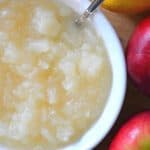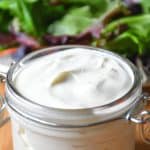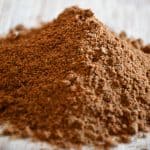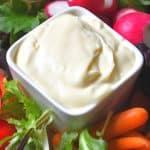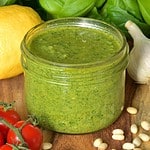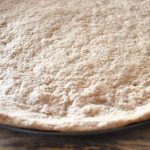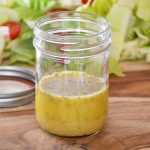This homemade low sodium Italian dressing is the perfect recipe to replace the store-bought version. It’s as delicious if not better and it’s as simple as combining everything in a jar and giving it a good shake.
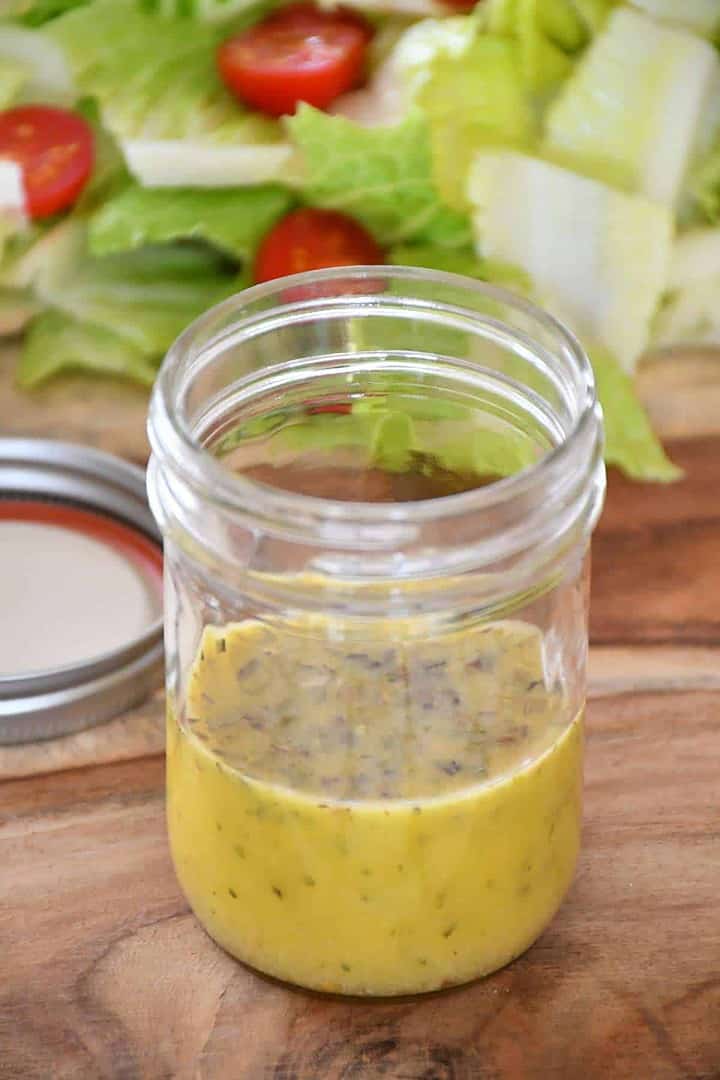
Kidney nutrition
As the name suggests, this Italian dressing is made without added salt. Instead, I used just a little Dijon mustard to make up for the lack of salt and add flavor at the same time.
The advantage of making your own low sodium Italian dressing is to avoid its commercial counterpart which may contain preservatives, additives and a lot more sodium.
Nutrition facts and claims
Here are the nutritional values and claims of this recipe.
For informational purposes only.
Low sodium Italian dressing ingredients
Here is the list of ingredients needed for this Italian vinaigrette and their usefulness.
Olive oil
Oil is an important part of many types of salad dressings. It adds flavor and richness to it and helps distribute the other dressing ingredients evenly.
White wine vinegar
Vinegar is also a common ingredient in salad dressing. The right amount will add sparkle and freshness to your salad. But be careful, a little too much will make your salad too acidic.
Lemon juice
Lemon juice does the same thing as vinegar. However, its flavor profile is different. I like to combine the two and get a more lemony and light taste.
Maple syrup
Sweet ingredients are used to balance acidity and provide a more rounded flavor profile. Here, a little goes a long way.
Herbs and spices
Like many salad dressings, this low sodium Italian dressing uses herbs and spices to add flavors. The combination of dried herbs and spices in this recipe is very similar to a salt free Italian seasoning blend.
Water
Water is used in this recipe to balance the flavor and mostly adjust the consistency of the dressing.
Nutritional yeast
This ingredient is optional. I use nutritional yeast instead of parmesan cheese to add a slight cheesy flavor. This allows me to avoid using dairy products and adding a lot of sodium.
How to use your low sodium Italian dressing
There are many ways to use this low sodium Italian dressing other than on a green salad so here are just a few.
Meat & tofu marinade
You can use this low sodium Italian dressing as is to marinate meats and tofu. Simply let your protein marinate for a few hours before cooking to get a lot more flavor out of it.
Salads of pasta, rice and legumes
Italian dressing can also be used not only for green salads, but also for any type of salad. It goes very well with red bean salads, pasta salads, etc.
Roasted vegetables
To make roasted veggies, just toss all your veggies in this low sodium dressing before putting them in the oven instead of using regular oil.
Low sodium Italian dressing variations
Here are some ideas for customizing your low sodium Italian dressing to your liking.
Different flavor profile
You can adjust the flavor profile to your preference. You can use different types of oil and vinegar and adjust their proportion. For example, you can use red wine vinegar with canola oil and reduce the amount of vinegar to get a lighter flavor and tone down the acidity.
You can also adjust the sweetness by using more or less maple syrup. If you want to avoid added sugar, you can also omit it altogether.
Different herbs and spices
Here you can use whatever you want. I just recommend following the same proportion of ingredients so you don’t overfill your dressing with herbs and spices.
For an easy swap, you can also replace all of these ingredients with a spice blend. You could use for example my low sodium Italian seasoning.
Fresh herbs
You can achieve a fresher taste by using fresh herbs in your Italian dressing. This recipe uses spices and dried herbs only for convenience.
Grated garlic
For a fresher, more pronounced garlic taste, you can use grated or pressed garlic instead of garlic powder. I just use garlic powder because again it’s more convenient and quick.
Adjust consistency
The easiest way to adjust the consistency is to adjust the amount of water. For a runnier dressing, add more and for a thicker one, omit it altogether.
Replace maple syrup
I tend to use maple syrup when I want to add a sweet touch, but you can substitute honey or even sugar depending on what you have in your pantry.
Low sodium Italian dressing conservation
Once prepared, you should use your low-sodium Italian dressing or store it in the refrigerator in an airtight container. It can be stored in the refrigerator for up to 2 weeks. To store my homemade dressing, I like to use mason jars which are inexpensive and quite handy in the kitchen.
However, note that your vinaigrette may solidify in the refrigerator and this is normal. After sitting for a while, the ingredients will separate and the olive oil will naturally solidify.
When you want to use this dressing, just let it sit at room temperature in the kitchen for a few minutes. Once the olive oil has become liquid again, shake the container vigorously to once again obtain a ready-to-use low salt Italian dressing.
To save time, my advice is to take it out of the fridge before preparing your salad. The oil should have enough time to liquefy.
Technically, you can also freeze this dressing, but I don’t recommend it. This will change the taste and texture. Being a 5 minute recipe, I recommend doing less if you think you’re going to waste some of it.
More low sodium condiment recipes
If you like this recipe, you might like these:
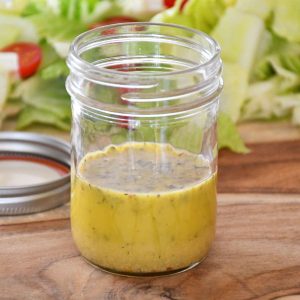
Low sodium Italian dressing
INGREDIENTS
Italian dressing essentials
- ¼ cup olive oil
- 2 tbsp white wine vinegar
- 1 tbsp lemon juice
- 1 tsp maple syrup or honey
- 1 tsp water
- 1 tsp nutritional yeast (optional)
- ½ tsp Dijon mustard
- ¼ tsp garlic powder
- ¼ tsp red pepper flakes
Dried herbs – Note 1
- ¼ tsp dried oregano
- ¼ tsp dried basil
- ¼ tsp dried parsley
INSTRUCTIONS
- Combine all ingredients in a mason jar, cover and shake vigorously until dressing is well combined and emulsified.
- Use immediately or store in the refrigerator in an airtight container.
NOTES
NUTRITION FACTS
For informational purposes only. Nutrition data is primarily calculated from the USDA National Database. Values may vary from accuracy of measurements, brands, nutritional data and more. All measurements are metric (1 cup = 250ml). Readers are encouraged to make their own calculations.


